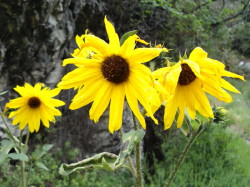 Becoming familiar with plants and wildflowers can be a rewarding way to enhance one's hiking experience. The huge number of plant species, however, can be overwhelming. My attempt here is to provide a resource to help non-botanist hikers indentify some of the plants in the San Gabriel Mountains.
Becoming familiar with plants and wildflowers can be a rewarding way to enhance one's hiking experience. The huge number of plant species, however, can be overwhelming. My attempt here is to provide a resource to help non-botanist hikers indentify some of the plants in the San Gabriel Mountains.
There are many excellent resources available, so my intent is to only provide a supplement and to point you to some resources that provide a more comprehensive knowledge of plants and wildflowers. I encourage you to not be overwhelmed by myriad of plant species and scientific complexities, but to simply start learning the names to some of the plants and wildflowers you see on the trail. An inquiring mind, observant eyes, and a little effort will go a long way in helping you to be more connected to the environment around you.
Plant Content on Dan's Hiking Pages:
Recommended Resources:
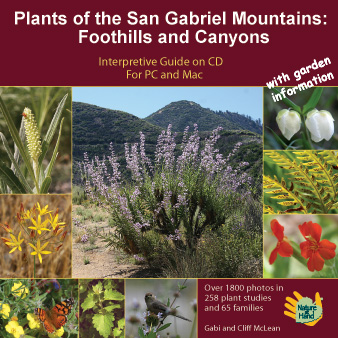 Plants of the San Gabriel Mountains: Foothills and Canyons / Interpretive Guide on CD (Nature at Hand, 2007) by Gabi and Cliff McLean. The McLeans have been associated with Eaton Canyon Nature Center for many years and have played a vital role in educating the public about nature. They have created an amazing interactive CD featuring 258 plants with 1800 quality photos. They have really made botany enjoyable and accessible for the non-botanists, like me. Detailed descriptions are given for each plant in easy-to-understand language. An extensive glossary of terms is only a click away and they provided audio pronunciations for botanical names and key botanical words. A variety of search options makes it easy to find the plant you are looking for. This user-friendly resource has been immensely helpful to me as a reference in plant identification and writing my blurbs about plants. It's the best 20 bucks I've ever spent on a plant guide! To purchase the CD, visit www.natureathand.com.
Plants of the San Gabriel Mountains: Foothills and Canyons / Interpretive Guide on CD (Nature at Hand, 2007) by Gabi and Cliff McLean. The McLeans have been associated with Eaton Canyon Nature Center for many years and have played a vital role in educating the public about nature. They have created an amazing interactive CD featuring 258 plants with 1800 quality photos. They have really made botany enjoyable and accessible for the non-botanists, like me. Detailed descriptions are given for each plant in easy-to-understand language. An extensive glossary of terms is only a click away and they provided audio pronunciations for botanical names and key botanical words. A variety of search options makes it easy to find the plant you are looking for. This user-friendly resource has been immensely helpful to me as a reference in plant identification and writing my blurbs about plants. It's the best 20 bucks I've ever spent on a plant guide! To purchase the CD, visit www.natureathand.com.
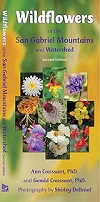 Wildflowers of the San Gabriel Mountains (San Gabriel Mountains Regional Conservancy, Second Edition 2015) by Ann Croissant, Ph.D. and Gerald Croissant, Ph.D., with photos by Shirley DeBraal. They have created a user-friendly guide featuring 87 plants, each with vivid color photos. Plant descriptions include brief notes about habitat, flowering characteristics, plant features, uses, uniquenesses, and meanings behind the scientific names. The flowers are grouped by color, making it easy to find what you are looking for. Since I am not a botanist, I have found the book to be great reference tool in plant identification and writing my blurbs about plants. And its convenient size fits in the pocket of my cargo pants for use on the trail. You can order the book from San Gabriel Mountains Regional Conservancy www.sgmrc.org and on Amazon.
Wildflowers of the San Gabriel Mountains (San Gabriel Mountains Regional Conservancy, Second Edition 2015) by Ann Croissant, Ph.D. and Gerald Croissant, Ph.D., with photos by Shirley DeBraal. They have created a user-friendly guide featuring 87 plants, each with vivid color photos. Plant descriptions include brief notes about habitat, flowering characteristics, plant features, uses, uniquenesses, and meanings behind the scientific names. The flowers are grouped by color, making it easy to find what you are looking for. Since I am not a botanist, I have found the book to be great reference tool in plant identification and writing my blurbs about plants. And its convenient size fits in the pocket of my cargo pants for use on the trail. You can order the book from San Gabriel Mountains Regional Conservancy www.sgmrc.org and on Amazon.
Websites:
- CalFlora.org, is a non-profit organization that hosts a huge database-driven website providing extensive information on wild California plants. Each "taxon report" includes links to other important sources, such as The Jepson Manuel (the botantists' bible for California flora) and CalPhotos, which is a massive photo database and will have lots of pictures of the plant you are studying (although, be aware that sometimes photos are misidentified). Calflora.org is the authoritative site I go to as a primary source when seeking information about a plant.
- Calfora.net (not associated with CalFlora.org), authored by Michael L. Charters, is an amazing website that provides treatments on nearly 2,300 plants. It is primarily list-driven, so it is most helpful if you already know a name of the plant you are studying. His field trips photo galley, however, features plant photos along various trails, which can be helpful in spotting a plant that you may be looking for. I have visited this site often and have been greatly helped by it.
- Native and Introduced Plants of Southern California, by Tom Chester with Jane Strong. My early uses of Tom's online resources were for his content on hiking in the San Gabriels. Tom, however, has morphed from an astrophysicist/hiker into a plant enthusiast extraordinaire. He is extensively involved in botanical field research and has provided a wealth of content online.
- NatureAtHand.com, authored by Cliff and Gabi McLean. The McLeans have been a vital force in educating the public about nature. Their website features a plant of the month, essays, photo galleries, blogs, native gardening tips, links, and more. Also included is a schedule of nature education activities such as docent-lead hikes, etc.
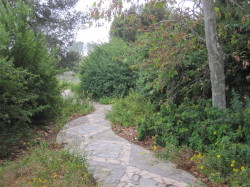 Nurseries and Gardens:
Nurseries and Gardens:
- California Botanic Garden (formerly Rancho Santa Ana Botanic Garden) in Claremont is the largest botanical garden dedicated exclusively to California native plants. I found it was well worth the $8 general admission (now $10) to wander around its 86 acres and see dozens of native plants I see while hiking the San Gabriels, and with lots of little signs telling exactly what the plants are. They offer guided tours, native plant workshops and sales, bird walks, and various other events. Definitely a thumbs up!
Below are links to several other commercial providers of wild plants. Their websites often present useful plant descriptions, particularly if you are interested in using native plants and wildflowers in your yard. I find that often their narratives about plants are more user-friendly than a list of botanical data.
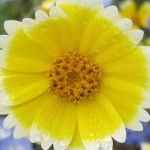 Tips for plant research on the web - When I want to learn more about a plant, I paste its botanical name (both genus and species, such as Toxicodendron diversilobum) into Google and click search. Using the botanical name will yield much better and focused results than using a common name. Remember that all sources are not created equal, so put more credence in top-level sources like CalFlora.org.
Tips for plant research on the web - When I want to learn more about a plant, I paste its botanical name (both genus and species, such as Toxicodendron diversilobum) into Google and click search. Using the botanical name will yield much better and focused results than using a common name. Remember that all sources are not created equal, so put more credence in top-level sources like CalFlora.org.
Nature Centers and Nature Trails:
As a hiker, I have found myself drawn to know more about plants and their habitats. Over the years, a primary source of plant learning has been nature centers and guided nature trails. Usually they provide some kind of interpretive explanations, either on a little sign next to a plant, or by a numbered sign corresponding to a printed guide. These have been immensely helpful to me and formed the primary foundation to my knowledge of wild plants. Here are the local nature centers/trails that I have frequented and which have been useful to me:
A note about "Plants and Wildflowers"
I've titled this section Plants and Wildflowers. But technically, a wildflower is a plant, so it is quite redundant to say plants and wildflowers. It's like saying "food and vegetables" or "buildings and houses." But I specifically list wildflowers because of their dominance in the plant world and, well, people love flowers. And I'm in good company when celebrated organizations like Theodore Payne Foundation for Wildflowers and Plants use both terms in their name.
 Animals of the San Gabriel Mountains
Animals of the San Gabriel Mountains